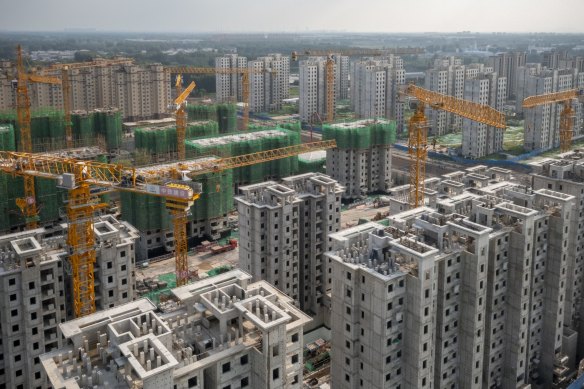This was published 1 year ago
Opinion
Fading giant: China is facing a difficult future
Stephen Bartholomeusz
Senior business columnistThe latest International Monetary Fund assessment of the state of China’s economy paints a more encouraging view of its near-term performance but highlights the longer-term structural challenges confronting its policymakers, complex threats that will be a brake on growth for years.
The IMF has upgraded its forecasts for China’s economic growth this year and next, both by 0.4 percentage points from projections it made only a month ago. It expects the economy to expand by 5.4 per cent this year and 4.6 per cent in 2024. It also, however, expects growth to slow to 3.5 per cent by 2028.
In the near term, while the composition of China’s growth seems patchy, it would seem that Beijing’s relatively modest efforts to stimulate the economy by building more factories and increasing its investment in manufacturing, are having some effect even before the trillion yuan ($214 billion) of new spending on infrastructure, announced late last month, has any impact.
A pickup in consumption, albeit from the low base set during last year’s zero COVID-affected economy, is offsetting a worrisome decline in China’s exports. Last Friday’s release of China’s trade data showed a 6.4 per cent decline in exports year-on-year, the sixth consecutive month of falling exports.
Reduced global demand amid rising interest rates in the major economies, the intensifying trade tensions with the US and its allies, the continuing restructuring of global supply chains, the tightening of US technology sanctions and the wars in Ukraine and the Middle East would all be impacting the world’s largest manufacturing base.
It’s not helping that foreign investment has fallen sharply.
That may be because investment has been scared off by China’s use of revised espionage laws to crack down on foreign companies’ access to economic and corporate data, or by the increased trade tensions between China and the West, or has been attracted to higher returns elsewhere as interest rate differentials between China and other economies widen or, more likely, all of the above.
In the September quarter, for the first time in the quarter of a century that data has been collected, net foreign direct investment was negative despite a concerted effort by Beijing to solicit more investment from offshore.
Some of the influences on China’s export performance – the trade tensions and supply chain diversification – are at least semi-permanent and overlay two other trends identified by the IMF: an ageing population and weak productivity.
While China’s policymakers continue to add manufacturing capacity to a sector that is already experiencing over-capacity, it does seem that the investments have boosted business and household confidence levels. Last week’s trade data also showed a 3 per cent rise in imports, presumably reflecting stronger consumption.

China’s crippled property sector is set to weigh on the economy for years to come. Credit: Bloomberg
The big structural challenges that have weighed on the economy, and which will continue to weigh on it for years to come, are high overall debt levels, the distressed property sector and the poor finances of local government authorities.
As the IMF noted, China’s remarkable growth rate in recent decades – 8 per cent GDP growth on average since 2000 – was driven by excessively high household savings that were used to finance infrastructure and residential property investment, with diminishing returns. That resulted in “elevated” debt levels.
It created a property bubble that burst when Xi Jinping imposed limits on property developers’ leverage, plunging the development sector into a crisis that continues to worsen and which has, because of their reliance on property-related income, infected local government finances and the banking system.
The IMF noted that the authorities had introduced numerous measures to support the property market but said more were needed to secure a recovery.
Its prescription is to let distressed developers fail, allow housing prices to find their level, fund completion of those half-completed developments and help viable developers repair their balance sheets.
So far, the authorities have tried to keep even the unviable big developers on life support rather than allow them to fail and spread contagion into the domestic financial system and economy, although foreign investors in the offshore bonds of the major developers have suffered massive losses.
While there could be some unpleasant short-term effects from purging the economy of insolvent developers, at some point the authorities will need to act to stabilise the still rapidly shrinking property market (property investment has fallen more than 9 per cent this year) at a smaller and more sustainable level.
They also need to do more to address local government finances.
The IMF said a comprehensive strategy is required to deal with the local government debt issue and restore their debt-servicing capacity and achieve sustainable levels of debt.
The local government sector relied heavily on property sales and off-balance sheet funding of developments for much of their income and the collapse of the sector has left them with limited capacity to service their debts and those of the highly leveraged financing vehicles they have used to fund infrastructure and their other investments.
The IMF said total local government debt, based on public financial statements, was about 45 per cent of GDP last year, with 80 per cent of the debt held by banks and the rest raised from corporate bond issues and borrowings from non-bank lenders (another stressed segment of China’s financial sector).
With about two-thirds of their assets fixed long-term investments in land and infrastructure, they have few liquid assets to meet their short-term funding needs. More than 30 per cent of local government debt, the IMF said, had an interest coverage ratio below one for the past three years and would be unviable without Beijing’s support.

China’s manufacturing sector is feeling pressure on a number of fronts.Credit: Bloomberg
If all the local government financing vehicles were restructured to ensure financial viability so that current earnings covered interest expenses, losses would be large, it said. It estimated that if banks absorbed half the cost of the debt restructuring they would face impairment charges of about 3.4 trillion yuan (about $726 billion).
China’s bigger banks could take the hits involved in a major restructuring of local government debts but the smaller regional banks, which have property exposure issues of their own, would probably have to be bailed out by Beijing.
It is that related property sector-local government finances conundrum that will, absent decisive and quite ruthless action from the authorities, weigh heavily on China’s economy and growth rate for years to come even as it faces the challenges of its declining population and the diminishing returns from investment in infrastructure and manufacturing.
The Business Briefing newsletter delivers major stories, exclusive coverage and expert opinion. Sign up to get it every weekday morning.